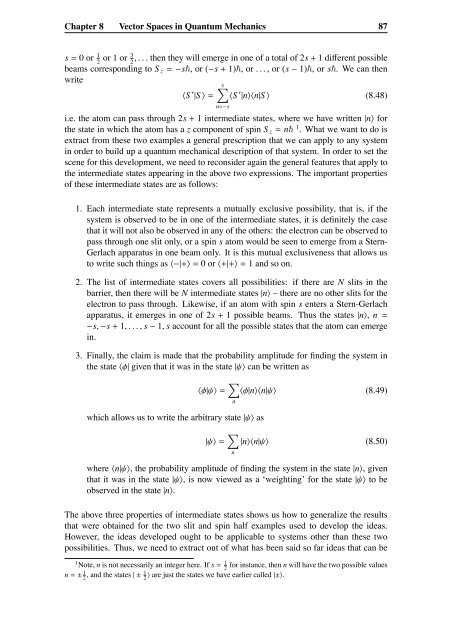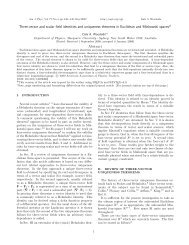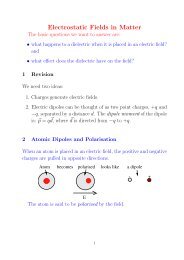Chapter 8 Vector Spaces in Quantum Mechanics
Chapter 8 Vector Spaces in Quantum Mechanics
Chapter 8 Vector Spaces in Quantum Mechanics
Create successful ePaper yourself
Turn your PDF publications into a flip-book with our unique Google optimized e-Paper software.
<strong>Chapter</strong> 8 <strong>Vector</strong> <strong>Spaces</strong> <strong>in</strong> <strong>Quantum</strong> <strong>Mechanics</strong> 87s = 0 or 1 or 1 or 3 , . . . then they will emerge <strong>in</strong> one of a total of 2s + 1 different possible2 2beams correspond<strong>in</strong>g to S z = −s, or (−s + 1), or . . . , or (s − 1), or s. We can thenwrites∑〈S ′ |S 〉 = 〈S ′ |n〉〈n|S 〉 (8.48)n=−si.e. the atom can pass through 2s + 1 <strong>in</strong>termediate states, where we have written |n〉 forthe state <strong>in</strong> which the atom has a z component of sp<strong>in</strong> S z = n 1 . What we want to do isextract from these two examples a general prescription that we can apply to any system<strong>in</strong> order to build up a quantum mechanical description of that system. In order to set thescene for this development, we need to reconsider aga<strong>in</strong> the general features that apply tothe <strong>in</strong>termediate states appear<strong>in</strong>g <strong>in</strong> the above two expressions. The important propertiesof these <strong>in</strong>termediate states are as follows:1. Each <strong>in</strong>termediate state represents a mutually exclusive possibility, that is, if thesystem is observed to be <strong>in</strong> one of the <strong>in</strong>termediate states, it is def<strong>in</strong>itely the casethat it will not also be observed <strong>in</strong> any of the others: the electron can be observed topass through one slit only, or a sp<strong>in</strong> s atom would be seen to emerge from a Stern-Gerlach apparatus <strong>in</strong> one beam only. It is this mutual exclusiveness that allows usto write such th<strong>in</strong>gs as 〈−|+〉 = 0 or 〈+|+〉 = 1 and so on.2. The list of <strong>in</strong>termediate states covers all possibilities: if there are N slits <strong>in</strong> thebarrier, then there will be N <strong>in</strong>termediate states |n〉 – there are no other slits for theelectron to pass through. Likewise, if an atom with sp<strong>in</strong> s enters a Stern-Gerlachapparatus, it emerges <strong>in</strong> one of 2s + 1 possible beams. Thus the states |n〉, n =−s, −s + 1, . . . , s − 1, s account for all the possible states that the atom can emerge<strong>in</strong>.3. F<strong>in</strong>ally, the claim is made that the probability amplitude for f<strong>in</strong>d<strong>in</strong>g the system <strong>in</strong>the state 〈φ| given that it was <strong>in</strong> the state |ψ〉 can be written aswhich allows us to write the arbitrary state |ψ〉 as∑〈φ|ψ〉 = 〈φ|n〉〈n|ψ〉 (8.49)n∑|ψ〉 = |n〉〈n|ψ〉 (8.50)nwhere 〈n|ψ〉, the probability amplitude of f<strong>in</strong>d<strong>in</strong>g the system <strong>in</strong> the state |n〉, giventhat it was <strong>in</strong> the state |ψ〉, is now viewed as a ‘weight<strong>in</strong>g’ for the state |ψ〉 to beobserved <strong>in</strong> the state |n〉.The above three properties of <strong>in</strong>termediate states shows us how to generalize the resultsthat were obta<strong>in</strong>ed for the two slit and sp<strong>in</strong> half examples used to develop the ideas.However, the ideas developed ought to be applicable to systems other than these twopossibilities. Thus, we need to extract out of what has been said so far ideas that can be1 Note, n is not necessarily an <strong>in</strong>teger here. If s = 1 2for <strong>in</strong>stance, then n will have the two possible valuesn = ± 1 2 , and the states | ± 1 2〉 are just the states we have earlier called |±〉.
















